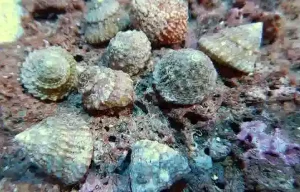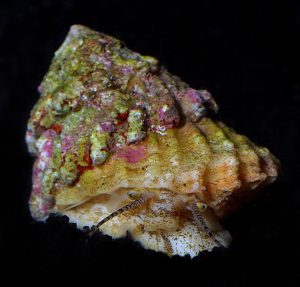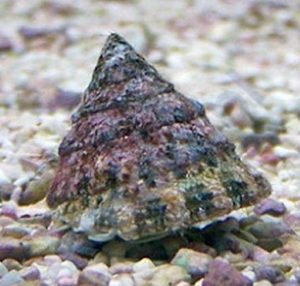Astraea Turbo Snail (Lithopoma tectum) known to tropical fish keeping enthusiasts as known as Turbo Snail, Astraea tecta, Top shell, Astraea Star Snail, Astraea Conehead Snail, West Indian Star snail, True Astrea Snail, Cat Eye Snail, Orange Cat Eye Snail, or Trochus shell is a ravenous algae eater found in the Caribbean Sea, the Gulf of Mexico, the Lesser Antilles and in the Atlantic Ocean, off the coast of Brazil.
Adult Astrea Turbo Snails are found in areas of turf algae along the outer reef flats and reef crests with abundant growths of stony corals at optimum depths between 3 ft and 33 ft, and occasionally as deep as 50 ft.
Juveniles prefer the shallower intertidal reef flats with growths of stony coral or rubble bottoms.
Both prefer environments where they can graze tough macroalgae and crustose like coralline algae growths found on hard substrates. The Astraea Turbo Snail (Lithopoma tectum) has a ravenous appetite for algae, especially hair algae.
There is a taxonomy problem with the Astrea snail that is normally not a problem with tropical fish keeping enthusiasts, but should be mentioned anyway.
The Astraea Snail commonly referred to as Astraea tecta, Top shell or Trochus shell, is in the Trochidae family, (a large family of marine gastropods mollusks of several hundred species) and is erroneous. Instead, the synonymous name Trochus tectus, now known as Lithopoma tectum, is correctly used by biologists.
Regardless of misidentifications in the trade or what scientific name you call them, the Astraea Turbo Snail has a multitude of similar looking relatives like the Mexican Turbo Snail (Turbo fluctuosa, Turbo fluctuosus) and Fenestrate Top Snail (Tectus fenestratus), that are often sold to tropical fish keeping enthusiasts as Astrea Turbo snails.
The primary color of the Astraea Turbo Snail shell is reddish orange, with white and olive green markings. They have thick, elevated, broad conical turbinate shells with numerous small conspicuous spikes protruding from it in a spiral form, which give it a star like appearance. The base is slightly convex with an oval operculum. Astrea Turbo Snails are gonochoric (separate male and female individuals), without any external sexual dimorphism.
Astraea Turbo Snails are docile, solitary, and obviously not aggressive. Because they lack the means to attack other tank inhabitants and have only their shell and operculum for protection, they like a calm environment with other peaceful tank mates. They do not scare easily and when placed on the bottom of the tank will slowly crawl onto the live rock or corals to explore all the crevices in the tank.
The Astrea Turbo Snail is reef safe and best housed in a well established reef aquarium with plenty of aged live rock arranged into hiding places and sufficient room for them to roam. They also do well in a live rock fish only tank with peaceful tank mates like dwarf shrimp and small, non carnivorous fish.
Astrea Turbo Snails are compatible with Sexy Shrimp, Red Fire shrimp (Lysmata debelius), Peppermint shrimp (Lysmata wurdemanni), Skunk Cleaner shrimp (Lysmata amboinensis), and snails like Bumble Bee Snail, Fighting Conch Snail, Cerith snails, Mexican turbo snails, Trochus Snails, etc.
Astrea Turbo Snails are often sold as members of “clean up crews” that will remove algae and clean the aquarium glass in marine tanks however, because of their adult size, they are not climbers like other smaller shelled species. Astrea snails have a difficult time righting themselves once they are knocked upside down and often need help from their owners. This is why Astrea Turbo Snails should never be housed with orange Claw Hermit Crabs (Calcinus tibicen).
Orange Claw Hermit Crabs crabs have a preference for occupying Astraea shells and are easy prey for an upside down Astrea. Coral banded shrimp can also be a bit too dangerous for these snails.
Astrea Turbo Snails are largely nocturnal. Their grazing activity picks up at dusk, continues throughout the night, and stops just before dawn. Juveniles and smaller specimens are usually more active than adults and are better climbers.
Like other invertebrates, the Astraea Turbo Snail is sensitive to copper and high nitrate levels. Like all marine fish, they require slow acclimation over 2 to 3 hours using the drip method.
The Astraea Turbo Snail is a broadcast spawner that reaches reproductive maturity at 6 – 8 months with fertilization taking place at night in the water column. The male initiates spawning and the female spawn in response to the presence of seed in the water. (Click Here) Females release over a million unfertilized eggs (oocytes) over a period of 5 to 10 minutes. The eggs are fertilized (contaminated) with a transparent mucus, floating in the seawater that will eventually clear up in the tank. Corals and other filter feeders quickly eat the particles that cloud the water.
Hatching occurs approximately 12 to 24 hours after fertilization, after the larvae reach the planktonic phase. The larvae come out as free swimming veligers and remain so for approximately 3 to 5 days before settling onto the reef substrate to begin grazing on fine filamentous algae and microorganisms.
Astrea snail larvae will gradually metamorphose to the crawling stage at 6 to 8 days. The mortality rate for the fertilized eggs is very high and only a few survive to become adults.
Fertilization, larval development, and larval metamorphosis is suppressed at salinities lower than 30‰.
In their natural habitat, Astraea Turbo Snails prefer feeding on nuisance hair algae, as well as cyanobacteria and diatoms. In an aquarium environment, they will also feed on leftover shrimp or fish foods pellets, flakes, Spirulina wafers
, frozen foods, etc.
When sufficient food levels are not present in the aquarium, their diet should be supplemented with blanched spinach or lettuce and vegetable based tablets or flake foods.
The Astraea Turbo Snail (Lithopoma tectum, Astraea tecta) is not a rare saltwater species and can be purchased almost anywhere at prices as low as $1.00 to $5.00 each. They are often sold online to tropical fish keeping enthusiasts as members of “cleanup crews” for reef tanks at even lower prices.
Astrea snails occasionally carry pests in the form of tiny parasitic Pyramid snails which can in rare instances even kill their host; so check your snails and remove any parasites prior to introduction.
Minimum Tank Size: 10 gallons
Aquarium Type: Established Reef or LRFO
Care Level: Easy
Temperament: Peaceful
Aquarium Hardiness: Hardy
Water Conditions: 71-75°F, dKH 7 to 12, pH 7.9-8.5, sg 1.023-1.026
Max. Size: 1″
Color Form: Orange, White, Olive Green
Diet: Specialty Herbivore
Compatibility: Reef Compatible
Origin: Caribbean Sea, Gulf of Mexico, Lesser Antilles
Family: Astraeinae
Lifespan: 3-5 years
Aquarist Experience Level: Beginner





